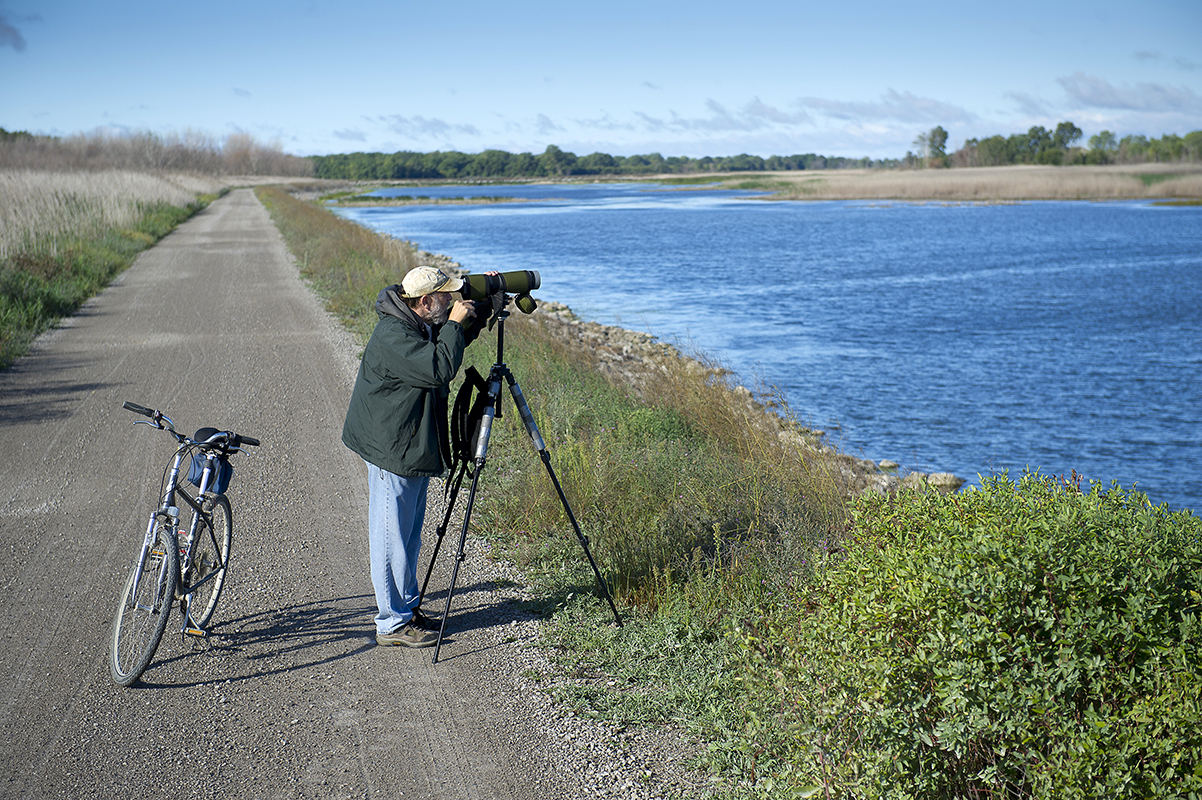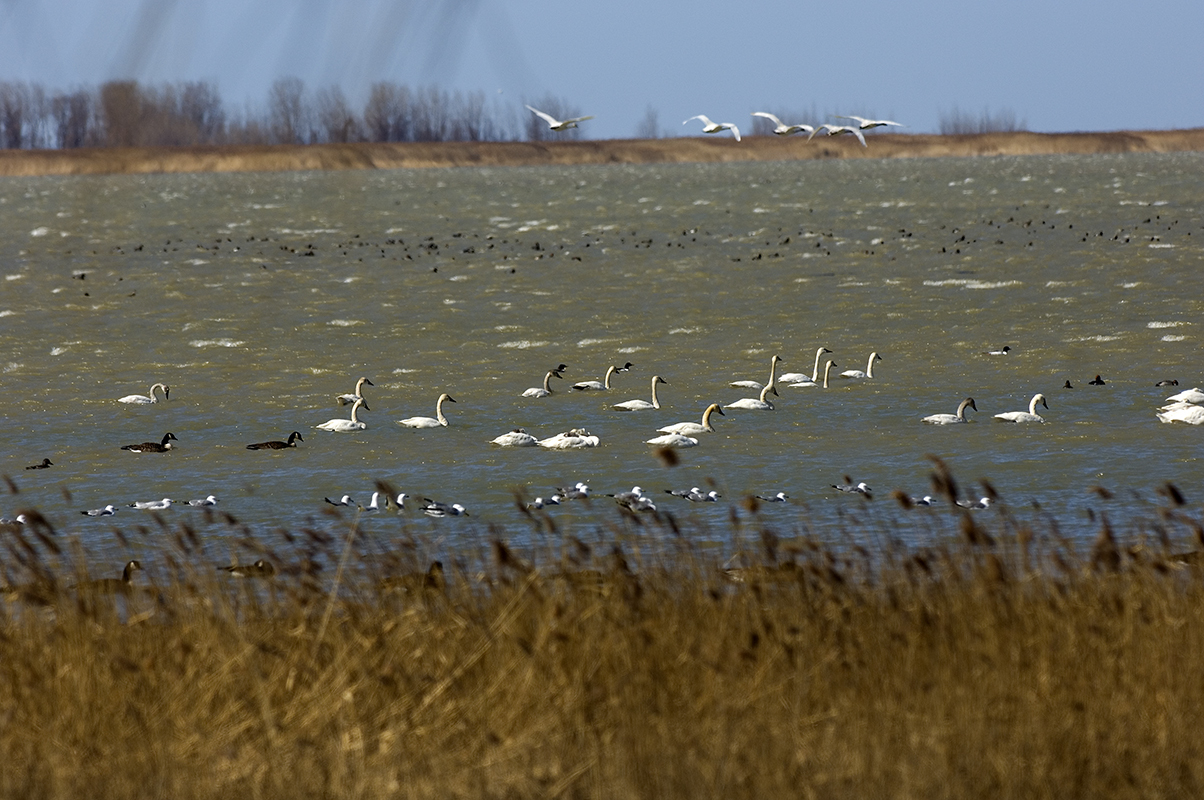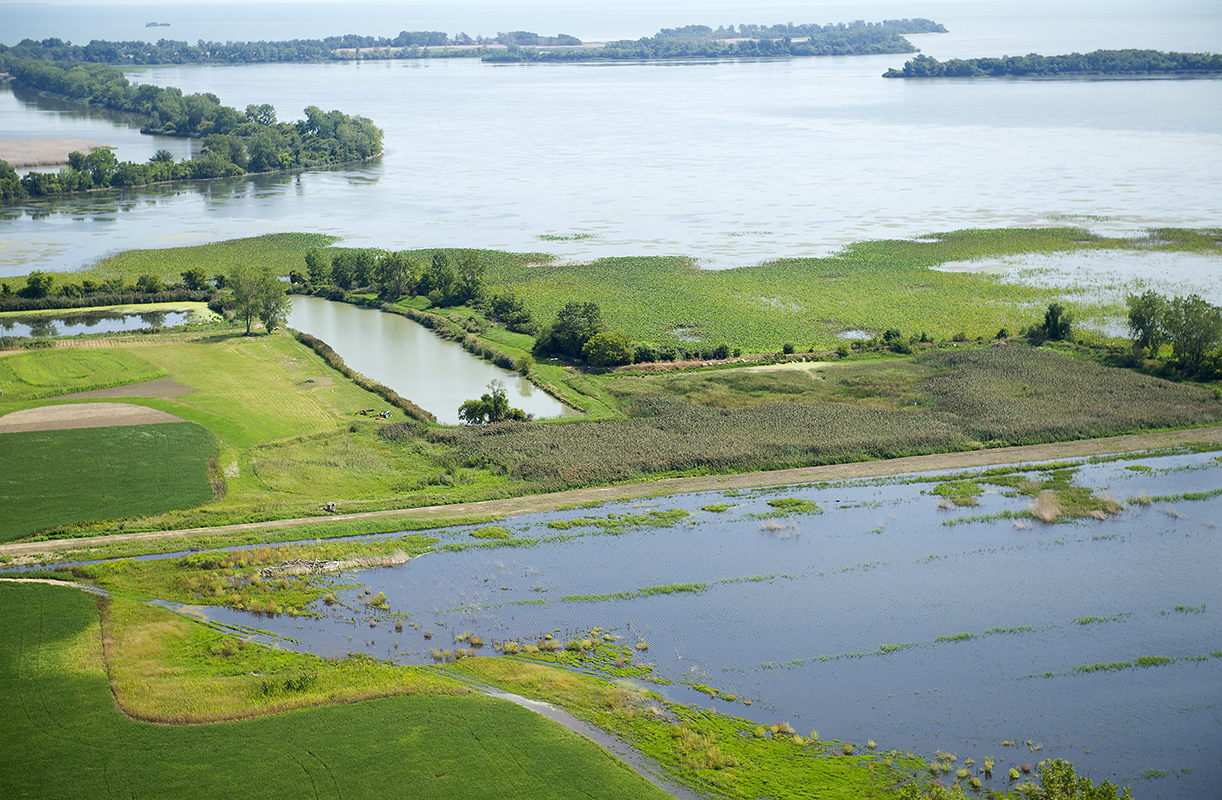Celebrate American Wetlands Month in May
Explore Michigan’s seven Wetland Wonders or a wetland near you
May is American Wetlands Month – a time to appreciate and enjoy these unique watery areas that are home to some of the most biologically diverse plant and animal life. Michigan has countless wetland areas scattered across the state, including seven the Michigan Department of Natural Resources has called "Wetland Wonders."
This year marks the 25th anniversary of the wetlands month commemoration begun in 1991 by federal, state, tribal, local, nonprofit and private sector partners.
 “Celebrating wetlands each May can help draw attention to the tremendous value of these vital areas and foster efforts to support their enhancement and expansion across the country,” said Holly Vaughn Joswick, a Michigan DNR wildlife outreach technician. “Celebrating wetlands each May can help draw attention to the tremendous value of these vital areas and foster efforts to support their enhancement and expansion across the country,” said Holly Vaughn Joswick, a Michigan DNR wildlife outreach technician.
From tiny ponds, home to singing spring frogs, to tremendous, wide wetland areas providing important resting and feeding areas for thousands of migrating waterfowl, nesting areas for songbirds and places for fish, turtles and numerous other species to thrive, wetlands contribute a great deal to the state’s benefit.
In addition, wetlands can provide wonderful opportunities to enjoy recreational pursuits across the state, including hunting, fishing, birdwatching and photography.
Economic benefits are also part of the wetlands picture. Wetlands can act as filters for future drinking water, flood control, improving water quality and serving as sites for growing rice and other wetland plants used to make medicines, cosmetics and other products.
Michigan's seven Wetland Wonders are premier Managed Waterfowl Hunt Areas located in the Lower Peninsula and managed by the DNR.
They include the Fennville Farm Unit at the Allegan State Game Area (Allegan County), Fish Point State Wildlife Area (Tuscola County), Harsens Island at the St. Clair Flats State Wildlife Area (St. Clair County), Muskegon County Wastewater Facility (Muskegon County), Nayanquing Point State Wildlife Area (Bay County), Pointe Mouillee State Game Area (Monroe and Wayne counties) and the Shiawassee River State Game Area (Saginaw County).
These areas, scattered across the southern half of the Lower Peninsula, were created in the 1950s and 1960s to provide exceptional waterfowl hunting and wildlife viewing opportunities. They are still managed today to provide waterfowl habitat for nesting and migration and for the benefit of other wetland wildlife. provide exceptional waterfowl hunting and wildlife viewing opportunities. They are still managed today to provide waterfowl habitat for nesting and migration and for the benefit of other wetland wildlife.
Since the beginning, the areas have been funded by hunting license fees, but they are open for anyone to visit, use and enjoy most of the year.
“Our Managed Waterfowl Hunt Areas offer access to some of the best waterfowl hunting and wildlife viewing areas in the state,” said Barb Avers, DNR waterfowl and wetlands specialist. “If you haven’t visited one of these areas before, we invite you to come experience these unique areas and see what they’re all about. It’s no surprise that several of our Wetland Wonders are among the top birdwatching destinations in Michigan.”
Here’s a closer look at each of Michigan’s seven Wetland Wonders.
Fennville Farm Unit – Allegan State Game Area (Allegan County)
The Fennville Farm Unit is part of the Allegan State Game Area. This 4,100-acre paradise for Canada goose hunting was purchased by the DNR from the A.M. Todd Co. of Kalamazoo in 1949. The property was originally used to grow peppermint, but has since been transformed into a waterfowl hunter's and wildlife viewer’s dream.
Not only does the Fennville Farm Unit have migrating waterfowl, it also provides opportunities to see many other wildlife species including upland sandpipers, golden eagles, dickcissels, white-tailed deer, ring-necked pheasants and wild turkeys.
 Fish Point State Wildlife Area (Tuscola County) Fish Point State Wildlife Area (Tuscola County)
Fish Point State Wildlife Area, located in Unionville, juts out into Saginaw Bay. Because of the tremendous variety and abundance of waterfowl found here, the Fish Point area has been called the "Chesapeake of the Midwest." During spring and fall migrations, the habitat and food resources at this site attract thousands of ducks and other water birds.
Fish Point is an excellent birding and wildlife watching spot. An observation tower and wildlife viewing trail provide excellent opportunities to see wildlife in and around the wildlife refuge.
Drive the county roads to view birds feeding in local farm fields and wetlands. Drive north on Ringle Road to see the tip of Fish Point and Saginaw Bay. During winter, it is not uncommon to see snowy owls at Fish Point. Tundra Swans move through in large numbers during spring and fall migrations. Shorebirds, herons, egrets, bitterns and other marsh birds make their homes here.
Harsens Island-St. Clair Flats State Wildlife Area (St. Clair County)
Harsens Island Managed Waterfowl Hunt Area on the shores of the St. Clair Flats is a short ferry ride from Algonac across the St. Clair River. Spanning 3,355 acres, this area has been a prime destination for waterfowl hunters for many years.
Outside the hunting season, Harsens Island is an excellent birding and wildlife watching spot. Viewers can find swans, herons, egrets, sandhill cranes, muskrats, mink, deer, bald eagles, osprey and much more. St. Clair Flats is also home to one of the largest black, and common, tern nesting colonies in the state.
 Muskegon County Wastewater System Muskegon County Wastewater System
When people think of wastewater facilities, many may think of smelly, unpleasant areas unfit for humans. However, hunters and birdwatchers know the Muskegon County Wastewater System is something special. With large storage lagoons and 3,500 acres of agriculture habitat, this area produces excellent habitat for ducks, geese and other birds.
The ponds at the Muskegon County Wastewater facility are an excellent birding spot. These large lagoons attract a wide variety of waterfowl species, including up to 12,000 ruddy ducks and over 5,000 northern shovelers during spring and fall migrations. Both seasonal migration bird counts are among the highest recorded for these species in Michigan. State birding rarities – eared grebes, golden eagles and lesser black-billed bulls among them – also turn up on the lagoons from time to time.
Nayanquing Point State Wildlife Area (Bay County)
The Nayanquing Point State Wildlife Area encompasses 1,505 acres and consists of cattail marsh, farmed upland fields and shrubby lowlands. Water control structures allow for the flooding of farm fields for excellent waterfowl habitat during fall migration. Waterfowl hunters aren’t the only ones who benefit from the habitat management at Nayanquing Point. It is also a popular destination for wildlife watchers and birders.
Many birdwatchers come to Nayanquing Point each year to see the large yellow-headed blackbird colony which can be viewed from the observation tower that overlooks the cattail marsh. In addition to the yellow-headed blackbirds, red-winged blackbirds, marsh wrens, American bitterns, least bitterns and swamp sparrows build their nests among the reeds in the spring and summer months. The area boasts a large concentration of warblers and other neo-tropical migrants in the spring, especially in the shrubby areas along the dikes.
Pointe Mouillee State Game Area (Monroe and Wayne counties)
Pointe Mouillee State Game Area is located in Rockwood on the western shore of Lake Erie. Pointe Mouillee is one of the largest freshwater marsh restoration projects in North America and is composed of 4,040 acres of cattail marsh, field, coastal wetlands and forest.
Point Mouillee is also a premier birding spot in Michigan. Birdwatchers from Michigan and Ohio regularly visit the marsh, field and forest habitats here to see ducks, shorebirds, herons, eagles, ospreys, warblers and more. Pointe Mouillee often hosts rare avian visitors. In recent years, glossy and white-faced ibises, black-necked stilts, a white wagtail, king rails and one black-headed gull made appearances in the marsh.
Some of the dikes have restricted access from Sept. 1 to Dec. 15. Check with the game area headquarters for more information on what access is permitted when.
Shiawassee River State Game Area (Saginaw County)
Shiawassee River State Game Area, located in St. Charles, is a massive floodplain located at the confluence of Swan Creek and the Flint, Shiawassee, Bad, Cass and Tittbawassee rivers. This unique geographical feature creates outstanding waterfowl habitat. The Shiawassee River State Game Area, at roughly 10,000 acres, is the largest Michigan has to offer.
The diversity of habitats at the site makes for great birdwatching and wildlife viewing. Not only can birders spot ducks, geese, grebes and coots, a number of warbler species, birds of prey – including bald eagles, golden eagles and ospreys – sparrows, woodpeckers and much more also move through the area, especially during spring and fall migrations.
 “We hope you’ll take the time to explore Michigan’s Wetland Wonders this spring and enjoy all that these areas have to offer,” Joswick said. “And if you can’t visit one of our Wetland Wonders, visit a wetland near you to enjoy the spectacular sights and sounds.” “We hope you’ll take the time to explore Michigan’s Wetland Wonders this spring and enjoy all that these areas have to offer,” Joswick said. “And if you can’t visit one of our Wetland Wonders, visit a wetland near you to enjoy the spectacular sights and sounds.”
Get more information on Michigan’s Managed Waterfowl Hunt Areas (including locations and maps). Several of the Wetland Wonders have seasonal closings for waterfowl hunting beginning in September or October.
Celebrating American Wetlands Month and visiting a Wetland Wonder are great ways to be a part of the Michigan Waterfowl Legacy. The legacy is a 10-year, cooperative partnership to restore, conserve and celebrate Michigan's waterfowl, wetlands and waterfowl hunting community. The initiative is a call to action to honor yesterday, engage today and build for tomorrow.
Watch a Wetland Wonders video. Learn more about American Wetlands Month.
Catch upcoming stories by subscribing to free, weekly “Showcasing the DNR” articles. Previous articles are available at www.michigan.gov/dnr-stories.
/Note to editors: Contact: Holly Vaughn Joswick, 313-396-6863 or Barb Avers, 517-641-4903. Accompanying photos are available below for download. Suggested captions follow. Credit: Michigan Department of Natural Resources./
Aerial (DSK442 025): An aerial view of the Pointe Mouillee State Game Area provides some idea of why this place is one of Michigan’s Wetland Wonders.
Birdwatching (DSK442 147): Birdwatching is among the numerous activities, beyond waterfowl hunting, available at Michigan’s Wetland Wonders.
Marsh (SAK320 009): Thousands of birds gathered during migration at the Fish Point State Wildlife Area, located in Unionville. The wildlife area juts out into Saginaw Bay.
Stilt (DSK62 063): A black-necked stilt is shown at the Pointe Mouillee State Game Area located in Rockwood on the western shore of Lake Erie. Stilts are among the uncommon birds found here with some regularity.
Swans (DSK320 061): Wetland areas provide important feeding and resting areas for migrating birds, like these tundra swans.
Additional photos: Barb Avers and Holly Vaughn Joswick/
The Michigan Department of Natural Resources is committed to the conservation, protection, management, use and enjoyment of the state’s natural and cultural resources for current and future generations. For more information, go to www.michigan.gov/dnr.
|

 “Celebrating wetlands each May can help draw attention to the tremendous value of these vital areas and foster efforts to support their enhancement and expansion across the country,” said Holly Vaughn Joswick, a Michigan DNR wildlife outreach technician.
“Celebrating wetlands each May can help draw attention to the tremendous value of these vital areas and foster efforts to support their enhancement and expansion across the country,” said Holly Vaughn Joswick, a Michigan DNR wildlife outreach technician. provide exceptional waterfowl hunting and wildlife viewing opportunities. They are still managed today to provide waterfowl habitat for nesting and migration and for the benefit of other wetland wildlife.
provide exceptional waterfowl hunting and wildlife viewing opportunities. They are still managed today to provide waterfowl habitat for nesting and migration and for the benefit of other wetland wildlife. Fish Point State Wildlife Area (Tuscola County)
Fish Point State Wildlife Area (Tuscola County) Muskegon County Wastewater System
Muskegon County Wastewater System
 “We hope you’ll take the time to explore Michigan’s Wetland Wonders this spring and enjoy all that these areas have to offer,” Joswick said. “And if you can’t visit one of our Wetland Wonders, visit a wetland near you to enjoy the spectacular sights and sounds.”
“We hope you’ll take the time to explore Michigan’s Wetland Wonders this spring and enjoy all that these areas have to offer,” Joswick said. “And if you can’t visit one of our Wetland Wonders, visit a wetland near you to enjoy the spectacular sights and sounds.”




